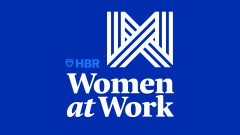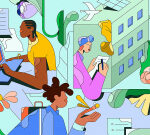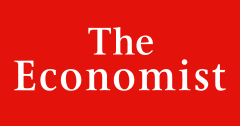Marti Bledsoe, a past guest of the show, recounts how she burned out, quit her job, intended to get a new job after taking a breather, and then wasn’t able to for over a year. That’s because someone in her family kept getting sick or hurt, she had to move twice, and all of the logistics and emotional support fell to her (because who else was going to do it?!).
These ever-expanding, relentless set of responsibilities is the norm for lots of women in the U.S., especially mothers. Sociologist Jessica Calarco joins Marti and Amy B to help make sense of Marti’s exhausting year of unpaid work and the forces that put her and other women into the position of being people’s default, unpaid caregiver.
Guest expert:
Jessica Calarco is a sociologist at the University of Wisconsin and the author of the book Holding It Together: How Women Became America’s Safety Net.
Resources:
- “Your Employees Are Also Caregivers. Here’s How to Support Them,” by Gretchen Gavett
- “Working While Managing Your Child’s Mental Health,” from Women at Work
- “When You’re Responsible for Eldercare,” from Women at Work
Sign up for the Women at Work newsletter.
Email us: womenatwork@hbr.org
AMY GALLO: You’re listening to Women at Work from Harvard Business Review. I’m Amy Gallo.
AMY BERNSTEIN: And I’m Amy Bernstein. Toward the end of 2023, our producer Amanda saw a LinkedIn post from one of our former guests, Marti Bledsoe, that made her eyes go wide. Marti had titled the post “A PRETTY BIG YEAR” in all caps and justifiably so. In January, the older of her two children, a freshman in high school, was still coming through a major depressive episode.
AMY GALLO: At the time, Marti was the executive director of The Kids Mental Health Foundation, so she knew enough about the disorder to quickly coordinate professional support. By March, happily, her teenager was in a better place mentally and emotionally.
AMY BERNSTEIN: But Marti wasn’t. She had resigned from her job because she was burnt out—just like so many parents straining to manage their kids’ anxiety or depression or anger while also keeping up at work.
AMY GALLO: As exhausted as she was, she immediately started applying to leadership roles elsewhere, hoping that changing workplaces would re-energize her. Between Zoom calls with people in her network, she cried and napped.
AMY BERNSTEIN: A month into that routine, the landlord of the house she’d been renting decided he was going to move in, which meant that Marti and her kids had 60 days to pack up and leave. That’s when her plans to bounce right back into the workforce really started to fall apart.
MARTI BLEDSOE: Yeah, I remember it as very chaotic and out of my control.
AMY GALLO: They spent 12 weeks at her mom’s house before she found a new house within the same school district that would fit them and her fiancé and his daughter.
AMY BERNSTEIN: The last day of the move, her fiancé slipped and tore his patellar tendon, an injury that requires surgery and a 16-week-plus recovery.
AMY GALLO: Then her mom, who lived nearby, needed emergency cataract surgery, then retina surgery, as well as a couple of dental surgeries. Then one kid was struggling to see well, another was struggling to breathe well. Each of these problems required multiple doctor’s visits and a considerable amount of Marti’s time and attention.
AMY BERNSTEIN: The grind left her utterly and completely spent.
MARTI BLEDSOE: Maintaining all the standards, the orthodontist appointments, getting the oil changed, following up on bills, making sure the mail got forwarded, renewing everybody’s prescriptions, driving my fiancé to physical therapy, driving my mom to eye recheck appointments and doing all kid driving since those two were my backup drivers, juggling summer camp for my 10-year-old, signing up, paying for, and then attending summer softball league for my oldest, coordinating at-home counseling three times a week to continue supporting my kids’ mental health, and then planning a year-end wedding and brunch to celebrate our newly blended family. That sounds like a happy one, but we actually thought we’d have to reschedule the wedding because of the torn patellar tendon and the crutches and the knee brace. We would’ve lost a lot of money had we done that.
AMY GALLO: He ended up being okay enough to walk down the aisle and got through their first dance.
MARTI BLEDSOE: And then it was the time of year for open enrollment, and I was trying to continue one set of benefits, figure out enrollment into another set of benefits because we had a qualifying event, which was very exciting, but also, the paperwork was mind-blowing and then there was more driving. I kept thinking, “Is this really my life?”
AMY BERNSTEIN: Jessica Calarco, who’s a sociologist at the University of Wisconsin, says this grind— this ever-expanding, relentless set of responsibilities—is the norm for lots of us in the US.
JESSICA CALARCO: Once women take a step back in the workforce, it can be very easy to fall into that default caregiver role and also leads to choices that then make it easier for you to be seen as the one who is logically most responsible for other types of care that comes down the line.
AMY GALLO: Jessica writes about the slippery slope in her book, Holding It Together: How Women Became America’s Safety Net.
AMY BERNSTEIN: She’s here to help Marti make sense of that “pretty big year,” as Marti called her LinkedIn post—or more like a year plus away from paid work. They’re both here to help those of you who’ve ever been consumed by caregiving understand the forces that got you there. Here’s my conversation with them.
AMY GALLO: I’ll be back afterwards to chat with you about it.
AMY BERNSTEIN: Marti, you started looking for a new job as soon as you resigned. How did you set out? What did you want to accomplish each week and then tell us what actually happened?
MARTI BLEDSOE: I wanted to spend an hour or two a day on LinkedIn, looking around at folks in my network, what they were up to, following companies that might be in my line of work that I wanted to stay in, and working on all the things that it takes today to get a job because you need multiple versions of your resume so they can get past AI bots that are screening. You need your elevator speech of what you’re looking for and what you can do, and I wanted to be consulting. I really felt like, gosh, I can look for a job and I can bill out at my hourly rate and then this really won’t feel like too much of a bump.
AMY BERNSTEIN: But your time wasn’t spent just on finding your next job, right?
JESSICA CALARCO: No, not at all. In fact, it was amazing how the hours got eaten up. I was packing to move, moving and unpacking for quite a bit of that time. I moved twice in the time that I wasn’t working—once in with my mother. Of all the ridiculous things I spent time doing at that point, I remember posting on Facebook to one of my networks, “Hey, I have 13 beautiful houseplants that are in great shape. I’m moving in with my mother. She has a cat. Can anybody watch these houseplants for 10 weeks?” Of course, the woman who volunteered lived 30 minutes away. So, I literally found myself arranging care for my houseplants. I was doing all kinds of things…dropping off kids, picking up kids. For a while there we were in summer vacation, which is hell for working parents. It was a different schedule every week, and it just felt like every time I would sit down, my phone would ping or somebody would need me and the week would be gone.
AMY BERNSTEIN: Jessica, help us understand this in the broader context. I mean, this is not an unfamiliar story to you. Why does this happen to women like Marti?
JESSICA CALARCO: Yeah, so other countries have invested in policies that help people manage their care needs and responsibilities. They have policies that allow people to live with dignity, to access economic opportunities, and to contribute equitably and sustainably to a shared project of care. In the US, we instead tell people that they should be able to take care of themselves and their families without relying on the government or even their employers for support, but the reality is that we can’t just DIY society. Some people, maybe most obviously children, but also people who are sick, people who are elderly can’t fully take care of themselves, and some jobs don’t pay enough to allow people to take care of themselves as well. So, acknowledging these realities would essentially destroy this illusion of a DIY society. But in the US, we essentially managed to maintain the illusion by relying on women to fill in the gaps, to be that social safety net for our families and for our community, and even for our economy, essentially by taking care of the people who can’t take care of themselves. We get women to do that work in part by grooming them for caregiving roles from the time they’re old enough to hold a baby doll, but also by pushing them into caregiving roles and then denying them any support in meeting those roles. Like Marti talked about, in those situations, it becomes very easy for women to become the default caregivers for their families. If you are a woman in a household where you are, often because of gender pay gaps, earning less than your male partner, if someone has to sacrifice their paid work hours, you’re probably going to do it. Then once you step into that default caregiving role, like Marti was saying, the visibility of that work as a caregiver as the default, then that compiled with the choices that default caregivers have to make to accommodate their caregiving responsibilities, makes it seem logical and natural for women who are in that default position to take on even more of the responsibility for care as those care needs increase over time.
AMY BERNSTEIN: So Marti, having read the book and having heard what Jessica just said, how does that shape or reshape the way you think about what happened in your own life?
MARTI BLEDSOE: It felt like it connected a lot of disparate feelings and concepts for me. From an intellectual standpoint, I felt a light bulb. It’s not just me. It’s truly the fact that the minute somebody sees a female with “time on her hands,” watch out.
AMY BERNSTEIN: How did that mess with your self-esteem, with your own concept of who you are, Marti?
MARTI BLEDSOE: I think it was very psychologically destabilizing, if that’s a way to explain it. I felt gaslit, but by myself and people around me. It was like, Oh, you had two or three full-time jobs. We’re going to take one away, and then the other two are going to fill in a lot of that room. But don’t forget, you should be trying to replace the third full-time job with another full-time job. The beginning of my job search, I looked back through all of my cover letters and I was applying for executive director, CEO, COO roles in mental health organizations, in child-focused organizations. Then I would think to myself, If they called me tomorrow to interview for this, how would I even manage it? Let’s say they offered it to me. Who’s going to go pick up the plants when it’s time to move them back to the house? I know that I can’t ask anybody else to do that, and if I did, it would probably be another woman who would fit it into the 57,000 things she has to do. So, I started to back off the level of what I felt like I could look for. I stopped going to the top of the org chart openings, and I started looking for director, associate director, senior manager type titles. Now, these are titles I haven’t held in my own career in 15 years, but I thought maybe I’m not going to be able at this time of my life to deliver what it takes to be at the top of an org chart because clearly everybody needs me. Even the people around me who benefited from it I don’t think were sitting around going, “Wow, we’re so lucky that you are caring and doing all these things.” I often think, Oh, my God. What if I had been working?
AMY BERNSTEIN: What if you had been working? So play that out for us. What if you had been working full-time?
MARTI BLEDSOE: I think it would’ve had to be either a role where I could say, “look, for the next, whatever, six months I’m going to have to work part-time or I’m going to have to use some short-term disability and some, you know, FMLA or somehow construct a scenario where I can give you part of the time, hopefully still quite a bit of the value. But I just cannot be available the way I would normally be or would like to be.” But I wonder sometimes, certainly had I been in a new job in that time where you’re learning so fast and you’re trying to meet everybody and you’re trying to prove yourself and get settled, that would’ve been a total disaster. So, it would’ve had to be somewhere where I’d been a while where they had those kinds of time benefits, where I had an understanding manager. I mean, you cannot overemphasize the importance of the individual manager and how they can make that viable or not viable. At the end of the day, I still might’ve lost my job because I just hit a wall of contribution. I think that’s one of the things that I often reflect on when we talk about balance, work-life balance. I’m often like, “Okay, fine. Let’s just say that you get your partnership and your parenting and your working and your self-health in some balance.” But if you, the person, are the fulcrum in the middle, I have a feeling you’re pretty worn down on all sides.
AMY BERNSTEIN: Yeah, because I struggle with picking up my dogs from daycare at the end of the day. So, I don’t know how you have made it through the kinds of demands you’ve had to face. Marti, your experience flies in the face of the advice all of us got in Lean In. I’m wondering how you think about that.
MARTI BLEDSOE: Lean In was published at a funny time in my career in that I had one young child and I thought I could sustain the pace I was living forever. I thought I could probably lean in. I bought the DIY guilt of Lean In, the come on girls, ask for the next thing, take the next project, take the risk. I guess I would say by the time some of the societal feedback to that concept had really started to get loud about it’s not just leaning in and it’s really not that easy for so many women… by that time, I had another child and I thought, Yeah, you know what? I actually want to rethink that because I don’t want to lean in any further. Not only at work, but I didn’t even want to lean in anymore at home. I wanted to lay down. I was like, can we stop leaning and take a rest here? So it does fly in the face of all of it.
AMY BERNSTEIN: So, Jessica, what Marti is saying I think is a more universal experience. I’m wondering from your perspective, is there a narrative that’s taking the place of Lean In and what is it?
JESSICA CALARCO: I mean, unfortunately, the Lean In narrative, I would argue, is still very much with us. Even if some people have pushed back against the specific notions of the book, for example, I think there’s still very much this expectation. Many of the women that I talk to for my research—first-time mothers or those who are just starting out in their careers—still very much feel this pressure to have it all, to try to be it all, to chase every opportunity, and also to set an example for other women as well, to be that leader in the workforce while also being that Pinterest perfect mom at home. If anything, it feels like the only narrative that is threatening to unseat Lean In at this point is maybe the tradwife narrative, in part because of how unsustainable it is to lean in, especially over the long term. I think that is part of where the… I talk a little bit about in my book about how some young women are leaning into the idea of being a housewife, instead of leaning in at work, in part because they realize that it is so unsustainable and they see one of the things that Lean In did was to deeply devalue the work of care and to ignore both the value that that brings to families and communities and even the joy that many of us can get from doing that care work, particularly when we have the time and the energy to do it well.
So, I think if anything, what we need is to go back to an older narrative that has actually been around even longer than Lean In, which is essentially the one that feminists gave us in the 1960s and 1970s and that really got co-opted by the corporate world when it came to messages like Lean In. I mean, to give an example, I mean Black feminist writer and activist, bell hooks was one of the vocal critics of the Lean In message drawing on her long body of work on these topics. She wrote a critique in 2013 of Lean In. She said, Sandberg sees women’s lack of perseverance as more of the problem than systemic inequality. She effectively uses her race and class power and privilege to promote a narrow definition of feminism that obscures and undermines visionist feminist concerns. Essentially, she’s pushing back against this notion that we should try to do this so individually. Really, that’s part of what my goal is to do with my own research too—is to help un-gaslight women, to tell women that guilt and stress are not normal or necessary parts of womanhood or parts of motherhood. I mean, essentially, we can help women to see that they have been tasked with serving as a social safety net in a society that has forced them to make do without the support that they need.
My hope is that I can show them how women’s self-help culture in particular deludes us into thinking that if we’re struggling to manage it all that it must be because we made the wrong choices, because we didn’t lean in, didn’t wash our face, didn’t get out of our own heads, didn’t “let that shit go,” to use some other popular book titles, for example.





